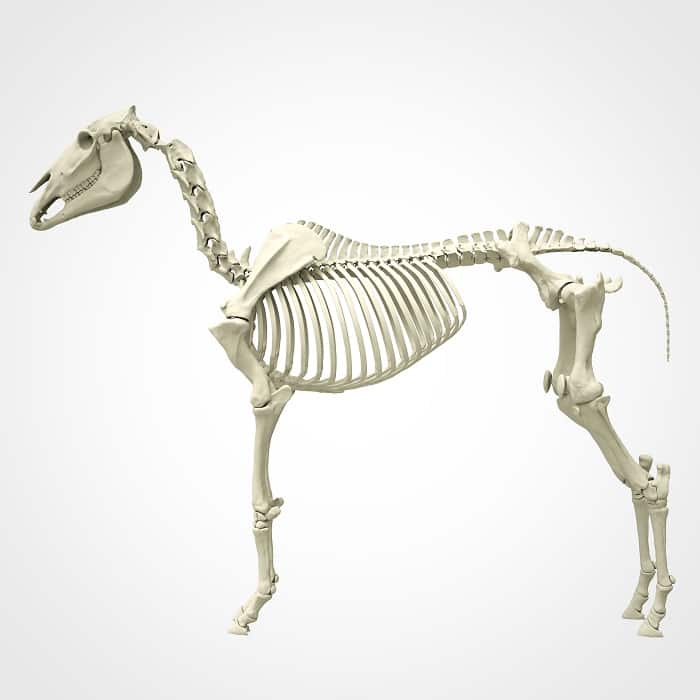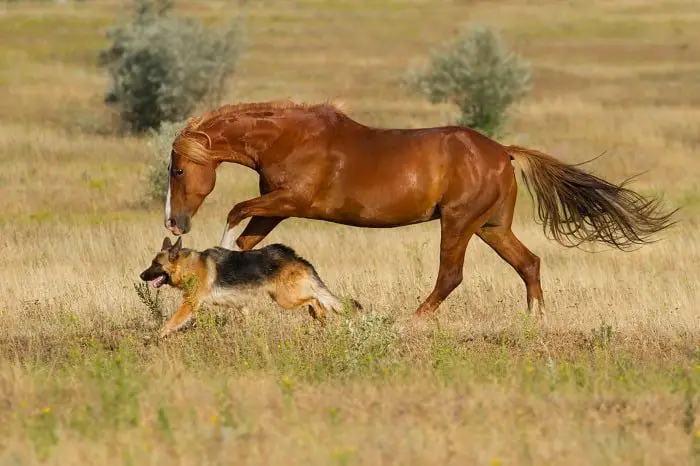Last Updated on March 24, 2023
How many ribs does a horse have and how much do you know about your horse’s anatomy? Unless you’re a vet or a veterinary student or an equine artist or a student of equine art, the answer is probably not much! However, horse anatomy is a fascinating topic, and it can be helpful for any horseman to learn a little about the horse’s skeleton!
The skeleton is a major part of the horse’s anatomy; it is this skeleton that makes a horse incredibly athletic, strong, and powerful in comparison to many other mammals. Every part of the horse’s skeletal structure is adapted to make these animals fit for survival in the wild, and that includes the ribcage. A horse’s ribcage has a large impact on a horse’s appearance and built.
Today we will be discussing the horse’s skeletal system and rib structure, along with some fascinating facts about why horses are built this way. Keep reading to find out more!
How Many Bones Do Horses Have in Their Skeleton?
The skeleton of a horse consists of an average of 205 bones, although this number can vary especially in certain breeds such as the Arabian. But what exactly is the skeleton of the horse?
The skeletal system is the name for the bones of the body, which are normally joined together through a system of complex joints. The skeletal system provides structure and support to the body and also protects vital organs. The ribcage of the horse performs all of these functions – it protects the heart and lungs, provides structural support to the abdominal cavity, and also plays an important role in respiration.
The horse’s skeleton is split into two sections. The axial skeleton is made up of the skull, spine, sternum, and ribs, while the fore and hind limbs belong to the appendicular skeletal system.
How Many Ribs Does a Horse Have?
Most horses have 18 pairs of ribs, giving a total of 36 ribs altogether. However, this number can vary, and it is not uncommon for horses to be born with an extra pair of ribs, giving them 38 ribs in total.
It is also common for a horse to have only one extra rib on either the right or left side, not a full extra pair, making the total number of ribs 37.
Understanding why some horses have more ribs than others, helps to understand the anatomy of the ribcage. So, let’s take a look at how the ribcage is formed!
Horse Rib Shape and Structure
The ribcage of a horse is made up of a series of bones laying parallel to each other. They gently curve around the thoracic cavity, forming a protective cage-like structure around the heart and lungs. This cavity is very large, allowing the horse’s lung capacity to be far superior to many other mammals.
One thing that all ribs have in common each rib aligns at the top with corresponding thoracic vertebrae. Each thoracic vertebra has two ribs that attach to it, one on each side of the horse.
The longest ribs in a horse’s ribcage are the seventh and eighth ribs; these ribs are located in the middle area of a horse’s barrel. The ribs get shorter as they progress toward a horse’s haunches.
When a horse does have a nineteenth pair of ribs or even just an extra one, they are often misshapen or deformed. Each space between a horse’s ribs is called the “intercostal” space, and the ribs can move apart to expand the thoracic cavity as the horse breathes.
What is the Difference Between a True Rib, a False Rib, and a Floating Rib?
In terms of anatomy, it is at the lower end of each rib where things start to change. It is this difference that leads to ribs being called names such as true ribs, false ribs, and floating ribs. Let’s take a look a what the difference between each type of rib is.
-
True rib
A horse’s ribs can be broken up into two major anatomical sections. First are the “true ribs;” these ribs are the first eight pairs of ribs in a horse’s ribcage. When you can “see a horse’s ribs,” these are the ribs you are seeing.
At their lower end, each pair of true ribs joins together underneath the horse via a small bone called sternebrae. These sternebrae are fused together, forming the sternum or breastbone. The correct term for true ribs is horses are sternal ribs.
-
False rib
The second part of a horse’s ribcage contains the next 10 pairs of ribs, which are called ‘false ribs’. These ribs do not join together underneath the horse; instead, they each attach to the rib next to it at the lower end via a piece of cartilage. This cartilage is called the costal arch, because each rib is progressively shorter than the previous one, forming a gentle arc which curves upwards around the abdomen of the horse.
The correct term for false ribs in horses is asternal ribs. Many people get false ribs confused with floating ribs.
-
Floating rib
Humans have two pairs of floating ribs, but they are far less common in horses. A floating rib attaches neither to the sternum nor the costal arch at the lower end; instead it ‘floats’ freely. In practical terms, the ribs are held in place by strong intercostal muscles, so your floating ribs are not about to start moving around! You are highly unlikely to find a horse that has floating ribs.
Using Rib Structure to Assess Equine Health and Wellbeing
Ribs can play a significant role in determining a horse’s well-being. In the 1970s, Dr. Don Henneke out of Texas A&M University developed a body scoring system that gauged a horse’s wellness and health by analyzing how visible the ribs were.
This system is still used today, and many horse owners and veterinarians use the visibility of and visible count of a horse’s ribs as an indication of that horse’s health and state of well-being.
The body condition scoring system requires owners to give their horse a numerical ranking, depending on how visible (or not) its ribs are. Over time this assessment should be periodically repeated, to note if there are any changes to the visibility or palpability of the ribs. This is a good system to use when trying out new feeds, new supplements, or even a new turnout schedule to try to observe and record how your horse’s body changes.
Considering Rib Structure When Fitting a Saddle
The shape of a horse’s ribcage is also important to consider when fitting a horse for a saddle. When a properly fitting saddle sits on a horse’s back, it is primarily supported by the horse’s ribcage and the muscles that go over it. It is the shape of the ribcage, along with the spinal column, which will determine the gullet size and width of your horse’s saddle.
The saddle’s width, referred to as the “tree” width, is determined by the width of the horse’s ribcage. Get a saddle that’s too narrow, and you risk pinching the horse’s withers and ribcage, and get a saddle that’s too wide, and you risk the saddle sliding back across the horse’s barrel.
The shape of a horse’s ribs also affects where the girth (English) or cinch (Western) sits. Naturally, the girth will slide to wherever the horse is the most narrow. Considering a horse’s barrel that starts behind the front legs, where it ends before the hind legs, the design of saddles is very logical.
The girth must sit behind the front legs because that is where the horse is the most narrow. This shape, of course, is due to the shape, size, and structure of a horse’s ribcage.
In some horses, the ribcage is barrel-shaped or gradually slants upwards toward a horse’s hind legs. These horses may require a specially fitted girth, breastplate, or crupper to hold the saddle in place.
Read more about 15 Main Parts Of A Horse Explained.
Horse Ribs Compared to Other Animals
The primary difference between a horse’s rib cage compared to rib cages of other animals is the number! Humans only have twelve ribs, while other animals such as cows, sheep, cats, goats, pigs, and dogs have thirteen.
Many believe that the horse’s long ribcage is what drew many early humans to try to ride horses as opposed to other animals.
Conclusion
Horses have a very unique rib cage, consisting of thirty-six to thirty-eight ribs, eighteen to nineteen pairs! A horse’s ribs play a large role in overall wellness and saddle fit, as well as providing owners and vets with a good tool to analyze and compare a horse over periods.
A horse’s ribcage is very different when compared to that of humans and other animals. It is one of the reasons the horse is a desirable animal for riding, allowing the horse to be able to carry large things on its back such as saddles and people.
I hope this article helped you develop a better understanding of a horse’s anatomical structure by teaching you about the equine rib cage! If so, please share this article and share with us any relevant experiences and stories you may have!
FAQs
What are false ribs in horses?
Horses normally have 10 pairs of false ribs on each side, and they form the ribcage section nearest to the horse's hindquarters. They originate from the thoracic vertebrae, and curve around the body, forming the vast ribcage which supports and protects the horse's lungs. They are called false ribs because, unlike true ribs, they do not attach to the sternum of the horse. Instead, they join onto the adjacent rib with a piece of cartilage, forming the costal arch.
What do false ribs do in horses?
False ribs play a crucial role in horse's mobility because they function as a lever for the horse's diaphragm. They have more flexibility and movement than the true ribs, and this allows horse to breathe more deeply and efficiently. This is particularly important when the horse is doing intensive physical activity, such as galloping.
False ribs, along with the rest of the ribcage, also protect the horse’s abdominal organs.
How does horse's false ribs function as a lever for horse’s diaphragm?
The diaphragm is a muscle flat sheet of muscle that helps a horse breathe. The lower end of the false ribs form a line of cartilage called the costal arch; the diaphragm attaches to these ribs at this point. When the horse inhales, the horse’s false ribs raise and pull upward on the diaphragm.
What are floating ribs?
Humans have two pairs of floating ribs, but these ribs are very rare in horses. A floating rib is one that attaches neither to the sternum or costal arch at the lower end; instead it 'floats' freely. In practical terms, the ribs are held in place by strong intercostal muscles, so your floating ribs are not about to start moving around! You are highly unlikely to find a horse that has floating ribs, and many people get floating ribs confused with false ribs.
Michael Dehaan is a passionate horse owner, horse rider, and lover of all things equine. He has been around horses since he was a child, and has grown to become an expert in the field. He has owned and ridden a variety of horses of different breeds, and has trained many to compete in shows and competitions. He is an experienced horseman, having worked with and competed many horses, including his own. He is an active member of the equestrian community, participating in events and teaching riding lessons.


